 | Information Architecture for the World Wide Web |  |

The organization of information in web sites and intranets is a major factor in determining success, and yet many web development teams lack the understanding necessary to do the job well. Our goal in this chapter is to provide a foundation for tackling even the most challenging information organization projects.
Organization systems are composed of organization schemes and organization structures . An organization scheme defines the shared characteristics of content items and influences the logical grouping of those items. An organization structure defines the types of relationships between content items and groups.
Before diving in, it's important to understand information organization in the context of web site development. Organization is closely related to navigation, labeling, and indexing. The hierarchical organization structures of web sites often play the part of primary navigation system. The labels of categories play a significant role in defining the contents of those categories. Manual indexing is ultimately a tool for organizing content items into groups at a very detailed level. Despite these closely knit relationships, it is both possible and useful to isolate the design of organization systems, which will form the foundation for navigation and labeling systems. By focusing solely on the logical grouping of information, you avoid the distractions of implementation details and design a better web site.
We navigate through organization schemes every day. Phone books, supermarkets, and television programming guides all use organization schemes to facilitate access. Some schemes are easy to use. We rarely have difficulty finding a friend's phone number in the alphabetical organization scheme of the white pages. Some schemes are intensely frustrating. Trying to find marshmallows or popcorn in a large and unfamiliar supermarket can drive us crazy. Are marshmallows in the snack aisle, the baking ingredients section, both, or neither?
In fact, the organization schemes of the phone book and the supermarket are fundamentally different. The alphabetical organization scheme of the phone book's white pages is exact. The hybrid topical/task-oriented organization scheme of the supermarket is ambiguous.
Let's start with the easy ones. Exact organization schemes divide information into well defined and mutually exclusive sections. The alphabetical organization of the phone book's white pages is a perfect example. If you know the last name of the person you are looking for, navigating the scheme is easy. Porter is in the P's which is after the O's but before the Q's. This is called " known-item" searching. You know what you're looking for and it's obvious where to find it. No ambiguity is involved. The problem with exact organization schemes is that they require the user to know the specific name of the resource they are looking for. The white pages don't work very well if you're looking for a plumber.
Exact organization schemes are relatively easy to design and maintain because there is little intellectual work involved in assigning items to categories. They are also easy to use. The following sections explore three frequently used exact organization schemes.
An alphabetical organization scheme is the primary organization scheme for encyclopedias and dictionaries. Almost all nonfiction books, including this one, provide an alphabetical index. Phone books, department store directories, bookstores, and libraries all make use of our 26-letter alphabet for organizing their contents. Alphabetical organization often serves as an umbrella for other organization schemes. We see information organized alphabetically by last name, by product or service, by department, and by format. See Figure 3-1 for an example.
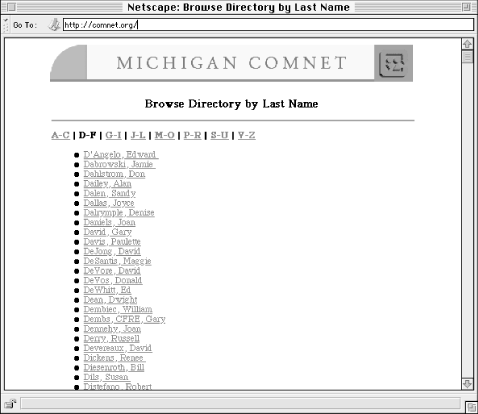
Certain types of information lend themselves to chronological organization. For example, an archive of press releases might be organized by the date of release (see Figure 3-2). History books, magazine archives, diaries, and television guides are organized chronologically. As long as there is agreement on when a particular event occurred, chronological schemes are easy to design and use.
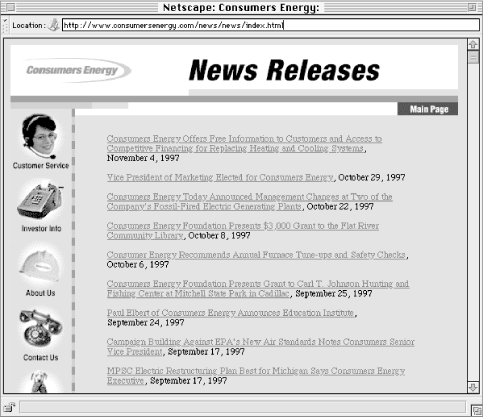
Place is often an important characteristic of information. We travel from one place to another. We care about the news and weather that affects us in our location. Political, social, and economic issues are frequently location-dependent. With the exception of border disputes, geographical organization schemes are fairly straightforward to design and use. Figure 3-3 shows an example of a geographic organization scheme.
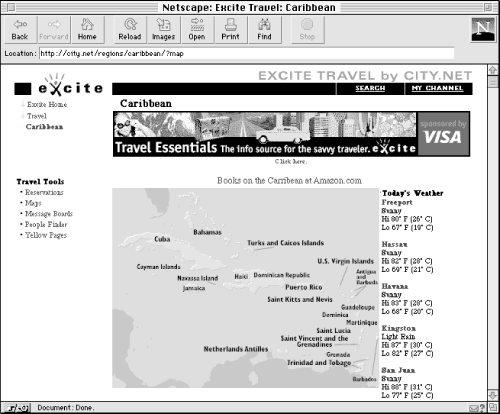
Now for the tough ones. Ambiguous organization schemes divide information into categories that defy exact definition. They are mired in the ambiguity of language and organization, not to mention human subjectivity. They are difficult to design and maintain. They can be difficult to use. Remember the tomato? Do we put it under fruit, berry, or vegetable?
However, they are often more important and useful than exact organization schemes. Consider the typical library catalog. There are three primary organization schemes. You can search for books by author, by title, or by subject. The author and title organization schemes are exact and thereby easier to create, maintain, and use. However, extensive research shows that library patrons use ambiguous subject-based schemes such as the Dewey Decimal and Library of Congress Classification Systems much more frequently.
There's a simple reason why people find ambiguous organization schemes so useful: We don't always know what we're looking for. In some cases, you simply don't know the correct label. In others, you may only have a vague information need that you can't quite articulate. For these reasons, information seeking is often iterative and interactive. What you find at the beginning of your search may influence what you look for and find later in your search. This information seeking process can involve a wonderful element of associative learning. Seek and ye shall find, but if the system is well-designed, you also might learn along the way. This is web surfing at its best.
Ambiguous organization supports this serendipitous mode of information seeking by grouping items in intellectually meaningful ways. In an alphabetical scheme, closely grouped items may have nothing in common beyond the fact that their names begin with the same letter. In an ambiguous organization scheme, someone other than the user has made an intellectual decision to group items together. This grouping of related items supports an associative learning process that may enable the user to make new connections and reach better conclusions. While ambiguous organization schemes require more work and introduce a messy element of subjectivity, they often prove more valuable to the user than exact schemes.
The success of ambiguous organization schemes depends on the initial design of a classification system and the ongoing indexing of content items. The classification system serves as a structured container for content items. It is composed of a hierarchy of categories and subcategories with scope notes that define the types of content to be included under each category. Once this classification system has been created, content items must be assigned to categories accurately and consistently. This is a painstaking process that only a librarian could love. Let's review a few of the most common and valuable ambiguous organization schemes.
Organizing information by subject or topic is one of the most challenging yet useful approaches. Phone book yellow pages are organized topically. That's why they're the right place to look when you need a plumber. Academic courses and departments, newspapers, and the chapters of most nonfiction books are all organized along topical lines.
While few web sites should be organized solely by topic, most should provide some sort of topical access to content. In designing a topical organization scheme, it is important to define the breadth of coverage. Some schemes, such as those found in an encyclopedia, cover the entire breadth of human knowledge (see Figure 3-4 for an example). Others, such as those more commonly found in corporate web sites, are limited in breadth, covering only those topics directly related to that company's products and services. In designing a topical organization scheme, keep in mind that you are defining the universe of content (both present and future) that users will expect to find within that area of the web site.
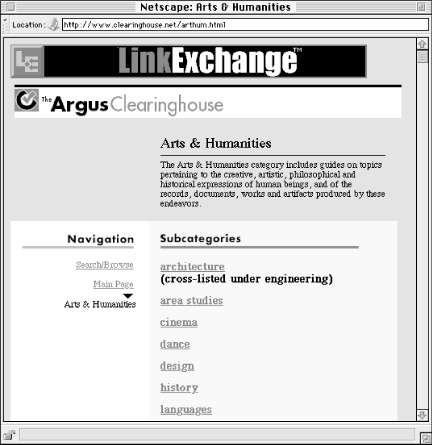
Task-oriented schemes organize content and applications into a collection of processes, functions, or tasks. These schemes are appropriate when it's possible to anticipate a limited number of high-priority tasks that users will want to perform. Desktop software applications such as word processors and spreadsheets provide familiar examples. Collections of individual actions are organized under task-oriented menus such as Edit, Insert, and Format.
On today's Web, task-oriented organization schemes are less common, since most web sites are content rather than application intensive. This should change as sites become increasingly functional. Intranets and extranets lend themselves well to a task orientation, since they tend to integrate powerful applications as well as content. Figure 3-5 shows an example of a task-oriented site.
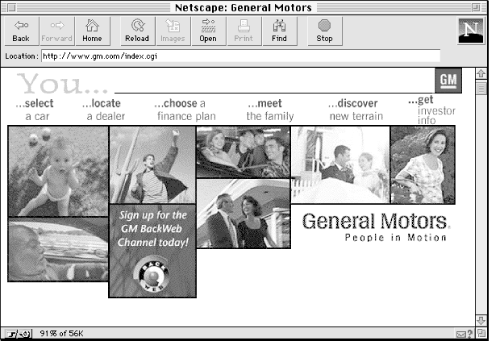
In cases where there are two or more clearly definable audiences for a web site or intranet, an audience-specific organization scheme may make sense. This type of scheme works best when the site is frequented by repeat visitors who can bookmark their particular section of the site. Also, it works well if there is value in customizing the content for each audience. Audience-oriented schemes break a site into smaller, audience-specific mini-sites, thereby allowing for clutter-free pages that present only the options of interest to that particular audience. See Figure 3-6 for an example.
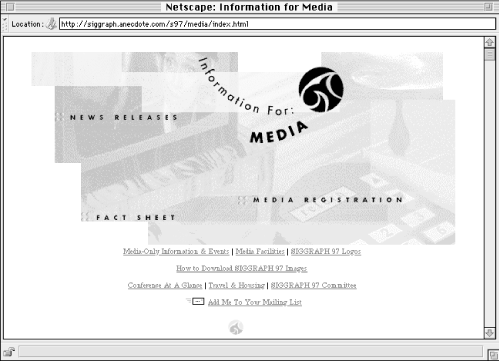
Audience-specific schemes can be open or closed. An open scheme will allow members of one audience to access the content intended for other audiences. A closed scheme will prevent members from moving between audience-specific sections. A closed scheme may be appropriate if subscription fees or security issues are involved.
Metaphors are commonly used to help users understand the new by relating it to the familiar. You need not look further than your desktop computer with its folders, files, and trash can or recycle bin for an example. Applied to an interface in this way, metaphors can help users understand content and function intuitively. In addition, the process of exploring possible metaphor-driven organization schemes can generate new and exciting ideas about the design, organization, and function of the web site (see "Metaphor Exploration" in Chapter 8, "Conceptual Design").
While metaphor exploration can be very useful while brainstorming, you should use caution when considering a metaphor-driven global organization scheme. First, metaphors, if they are to succeed, must be familiar to users. Organizing the web site of a computer hardware vendor according to the internal architecture of a computer will not help users who don't understand the layout of a motherboard.
Second, metaphors can introduce unwanted baggage or be limiting. For example, users might expect a virtual library to be staffed by a librarian that will answer reference questions. Most virtual libraries do not provide this service. Additionally, you may wish to provide services in your virtual library that have no clear corollary in the real world. Creating your own customized version of the library is one such example. This will force you to break out of the metaphor, introducing inconsistency into your organization scheme.
Figure 3-7 shows a more offbeat metaphor example.
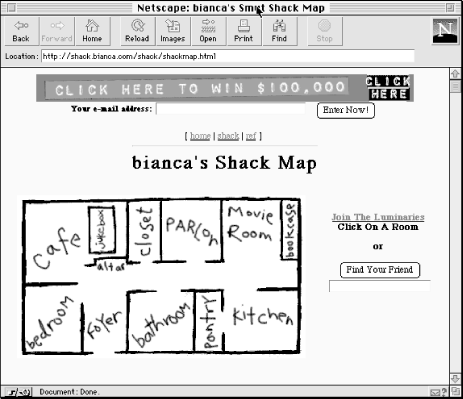
The power of a pure organization scheme derives from its ability to suggest a simple mental model for users to quickly understand. Users easily recognize an audience-specific or topical organization. However, when you start blending elements of multiple schemes, confusion is almost guaranteed. Consider the example of a hybrid scheme in Figure 3-8. This hybrid scheme includes elements of audience-specific, topical, metaphor-based, and task-oriented organization schemes. Because they are all mixed together, we can't form a mental model. Instead, we need to skim through each menu item to find the option we're looking for.
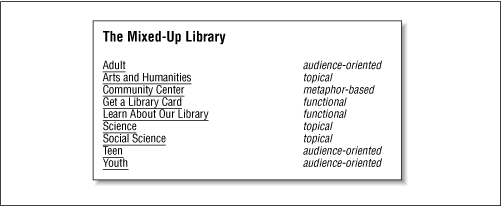
Examples of hybrid schemes are common on the Web. This happens because it is often difficult to agree upon any one scheme to present on the main page, so people throw the elements of multiple schemes together in a confusing mix. There is a better alternative. In cases where multiple schemes must be presented on one page, you should communicate to designers the importance of retaining the integrity of each scheme. As long as the schemes are presented separately on the page, they will retain the powerful ability to suggest a mental model for users (see Figure 3-9 for an example).
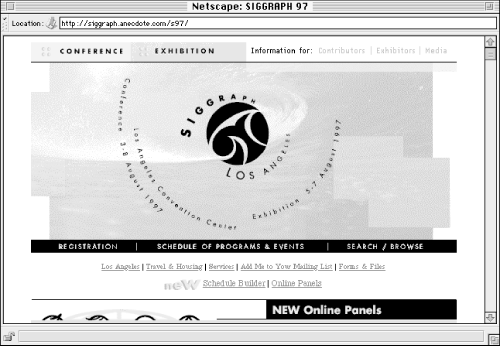
Organization structure plays an intangible yet very important role in the design of web sites. While we interact with organization structures every day, we rarely think about them. Movies are linear in their physical structure. We experience them frame by frame from beginning to end. However, the plots themselves may be non-linear, employing flashbacks and parallel subplots. Maps have a spatial structure. Items are placed according to physical proximity, although the most useful maps cheat, sacrificing accuracy for clarity.
The structure of information defines the primary ways in which users can navigate. Major organization structures that apply to web site and intranet architectures include the hierarchy, the database-oriented model, and hypertext. Each organization structure possesses unique strengths and weaknesses. In some cases, it makes sense to use one or the other. In many cases, it makes sense to use all three in a complementary manner.
The foundation of almost all good information architectures is a well-designed hierarchy. In this hypertextual world of nets and webs, such a statement may seem blasphemous, but it's true. The mutually exclusive subdivisions and parent-child relationships of hierarchies are simple and familiar. We have organized information into hierarchies since the beginning of time. Family trees are hierarchical. Our division of life on earth into kingdoms and classes and species is hierarchical. Organization charts are usually hierarchical. We divide books into chapters into sections into paragraphs into sentences into words into letters. Hierarchy is ubiquitous in our lives and informs our understanding of the world in a profound and meaningful way. Because of this pervasiveness of hierarchy, users can easily and quickly understand web sites that use hierarchical organization models. They are able to develop a mental model of the site's structure and their location within that structure. This provides context that helps users feel comfortable. See Figure 3-10 for an example of a simple hierarchical model.
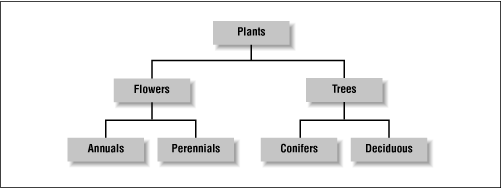
Because hierarchies provide a simple and familiar way to organize information, they are usually a good place to start the information architecture process. The top-down approach allows you to quickly get a handle on the scope of the web site without going through an extensive content inventory process. You can begin identifying the major content areas and exploring possible organization schemes that will provide access to that content.
When designing information hierarchies on the Web, you should remember a few rules of thumb. First, you should be aware of, but not bound by, the idea that hierarchical categories should be mutually exclusive. Within a single organization scheme, you will need to balance the tension between exclusivity and inclusivity. Ambiguous organization schemes in particular make it challenging to divide content into mutually exclusive categories. Do tomatoes belong in the fruit or vegetable or berry category? In many cases, you might place the more ambiguous items into two or more categories, so that users are sure to find them. However, if too many items are cross-listed, the hierarchy loses its value. This tension between exclusivity and inclusivity does not exist across different organization schemes. You would expect a listing of products organized by format to include the same items as a companion listing of products organized by topic. Topic and format are simply two different ways of looking at the same information.
Second, it is important to consider the balance between breadth and depth in your information hierarchy. Breadth refers to the number of options at each level of the hierarchy. Depth refers to the number of levels in the hierarchy. If a hierarchy is too narrow and deep, users have to click through an inordinate number of levels to find what they are looking for (see Figure 3-11). If a hierarchy is too broad and shallow, users are faced with too many options on the main menu and are unpleasantly surprised by the lack of content once they select an option.
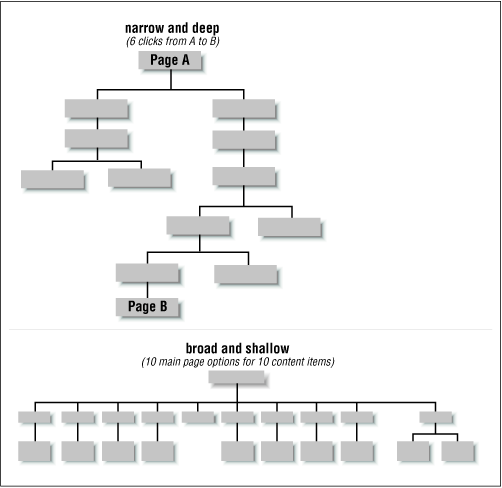
In considering breadth, you should be sensitive to the cognitive limits of the human mind. Particularly with ambiguous organization schemes, try to follow the seven plus-or-minus two rule.[4] Web sites with more than ten options on the main menu can overwhelm users.
[4]G. Miller, "The Magical Number Seven, Plus or Minus Two: Some Limits on our Capacity for Processing Information," Psychological Review 63, no. 2 (1956): 81-97.
In considering depth, you should be even more conservative. If users are forced to click through more than four or five levels, they may simply give up and leave your web site. At the very least, they'll become frustrated.
For new web sites and intranets that are expected to grow, you should lean towards a broad and shallow rather than narrow and deep hierarchy. This approach allows for the addition of content without major restructuring. It is less problematic to add items to secondary levels of the hierarchy than to the main page, for a couple of reasons. First, the main page serves as the most prominent and important navigation interface for users. Changes to this page can really hurt the mental model they have formed of the web site over time. Second, because of its prominence and importance, companies tend to spend lots of care (and money) on the graphic design and layout of the main page. Changes to the main page can be more time consuming and expensive than changes to secondary pages.
Finally, when designing organization structures, you should not become trapped by the hierarchical model. Certain content areas will invite a database or hypertext-based approach. The hierarchy is a good place to begin, but is only one component in a cohesive organization system.
Hypertext is a relatively new and highly nonlinear way of structuring information. A hypertext system involves two primary types of components: the items or chunks of information which are to be linked, and the links between those chunks. These components can form hypermedia systems that connect text, data, image, video, and infoarch chunks. Hypertext chunks can be connected hierarchically, non-hierarchically, or both (see Figure 3-12).
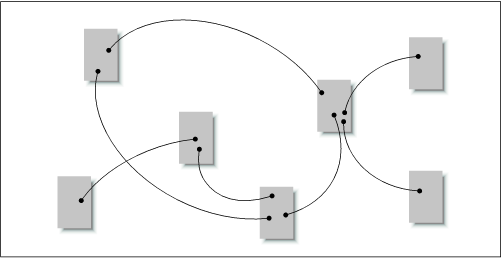
Although this organization structure provides you with great flexibility, it presents substantial potential for complexity and user confusion. As users navigate through highly hypertextual web sites, it is easy for them to get lost. It's as if they are thrown into a forest and are bouncing from tree to tree, trying to understand the lay of the land. They simply can't create a mental model of the site organization. Without context, users can quickly become overwhelmed and frustrated. In addition, hypertextual links are often personal in nature. The relationships that one person sees between content items may not be apparent to others.
For these reasons, hypertext is rarely a good candidate for the primary organization structure. Rather, hypertext can be used to complement structures based upon the hierarchical or database models.
Hypertext allows for useful and creative relationships between items and areas in the hierarchy. It usually makes sense to first design the information hierarchy and then to identify ways in which hypertext can complement the hierarchy.
Most of us are familiar with databases. In fact, our names, addresses, and other personal information are included in more databases than we care to imagine. A database is a collection of records. Each record has a number of associated fields. For example, a customer database may have one record per customer. Each record may include fields such as customer name, street address, city, state, ZIP code, and phone number. The database enables users to search for a particular customer or to search for all users with a specific ZIP code. This powerful field-specific searching is a major advantage of the database model. Additionally, content management is substantially easier with a database than without. Databases can be designed to support time-saving features such as global search and replace and data validation. They can also facilitate distributed content management, employing security measures and version control systems that allow many people to modify content without stepping on each others' toes.
Finally, databases enable you to repurpose the same content in multiple forms and formats for different audiences. For example, an audience-oriented approach might benefit from a context-sensitive navigation scheme in which each audience has unique navigation options (such as returning to the main page of that audience area). Without a database, you might need to create a separate version of each HTML page that has content shared across multiple audiences. This is a production and maintenance nightmare! In another scenario, you might want to publish the same content to your web site, to a printed brochure, and to a CD-ROM. The database approach supports this flexibility.
However, the database model has limitations. The records must follow rigid rules. Within a particular record type, each record must have the same fields, and within each field, the formatting rules must be applied consistently across records. This highly structured approach does not work well with the heterogeneous content of many web sites. Also, technically it's not easy to place the entire contents (including text, graphics, and hypertext links) of every HTML page into a database. Such an approach can be very expensive and time consuming.
For these reasons, the database model is best applied to subsites or collections of structured, homogeneous information within a broader web site. For example, staff directories, news release archives, and product catalogs are excellent candidates for the database model.
Typically, the top-down process of hierarchy design will uncover content areas that lend themselves to a database-driven solution. At this point, you will do well to involve a programmer, who can help not only with the database implementation but with the nitty-gritty data modeling issues as well (see Figure 3-13).
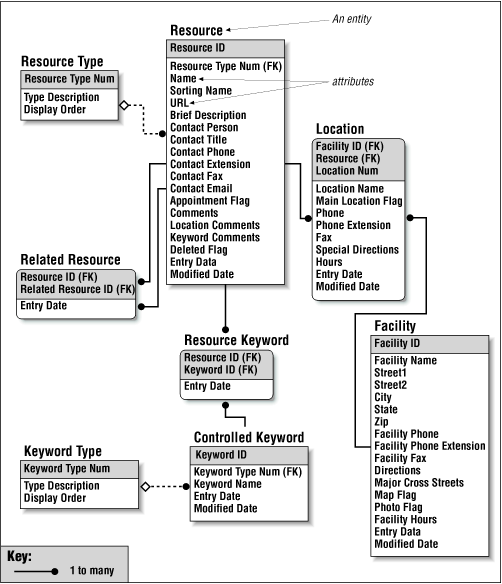
Within each of the content areas identified as candidates for a database-driven solution, you will need to begin a bottom-up approach aimed at identifying the content and structure of individual record types.
For example, a staff directory may have one record for each staff member. You will need to identify what information will be made available for each individual. Some fields such as name and office phone number may be required. Others such as email address and home phone number may be optional. You may decide to include an expertise field that includes keywords to describe the skills of that individual. For fields such as this, you will need to determine whether or not to define a controlled vocabulary.
A controlled vocabulary specifies the acceptable terms for use in a particular field. It may also employ scope notes that define each term.
For example, the table below lists the controlled vocabulary for keywords in the ecology area of the Argus Clearinghouse web site (see http://www.clearinghouse.net). The scope notes explain that ecology is "the branch of biology dealing with the relation of living things to their environments." (See Figure 5-2 for an example of scope notes in action.) This information is useful for the staff who index resources and the users who navigate the web site.
|
Controlled Vocabulary Argus Clearinghouse: Environment: Ecology |
|
|---|---|
|
biodiversity |
coastal zone management |
|
conservation |
ecology (general) |
|
environment |
environmental health |
|
environmental resources |
environmental science |
|
environmental studies |
land use |
|
reef conservation |
roadkill |
|
water resources |
wetlands conservation |
|
wildlife |
wildlife management |
|
wildlife rehabilitation |
Use of a controlled vocabulary imposes an important degree of consistency that supports searching and browsing. Once users understand the controlled vocabulary, they know that a search on biodiversity should retrieve all relevant documents. They do not also need to try biological diversity. In addition, this consistency allows you to automatically generate browsable indexes. This is a great feature for users, is not very difficult to implement, and is extremely efficient from a site maintenance perspective (see Figure 3-14).
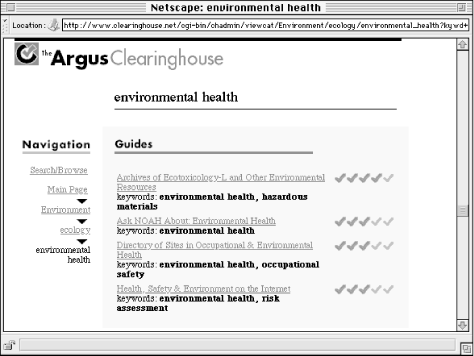
However, creating and maintaining a controlled vocabulary is not a simple task. In many cases, complementing a simple controlled vocabulary that divides the items into broad categories with an uncontrolled keyword field provides a good balance of structure and flexibility. (For more on creating controlled vocabularies, see Section 5.4.1.3, "Controlled vocabularies and thesauri" in Chapter 5, "Labeling Systems".)
Once you've constructed the record types and associated controlled vocabularies, you can begin thinking about how users should be able to navigate this information. One of the major advantages of a database-driven approach is the power and flexibility it affords for the design of searching and browsing systems (see Figure 3-15). Every field presents an additional way to browse or search the directory of records.
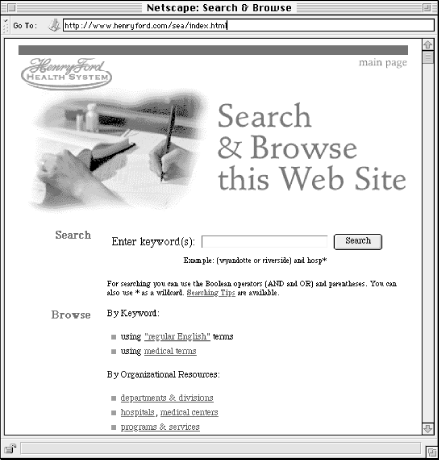
The database-driven approach also brings greater efficiency and accuracy to data entry and content management. You can create administrative interfaces that eliminate worry about HTML tags and ensure standard formatting across records through the use of templates. You can integrate tools that perform syntax and link checking. Of course, the search and browse indexes can be rebuilt automatically after each addition, deletion, or modification.
Content databases can be implemented in a variety of ways. The database management software can be configured to produce static HTML pages in batch mode or to generate dynamic HTML pages on-the-fly as users navigate the site. These implementation decisions will be influenced by technical performance issues (e.g., bandwidth and CPU constraints) and have little impact upon the architecture.

Copyright © 2002 O'Reilly & Associates. All rights reserved.